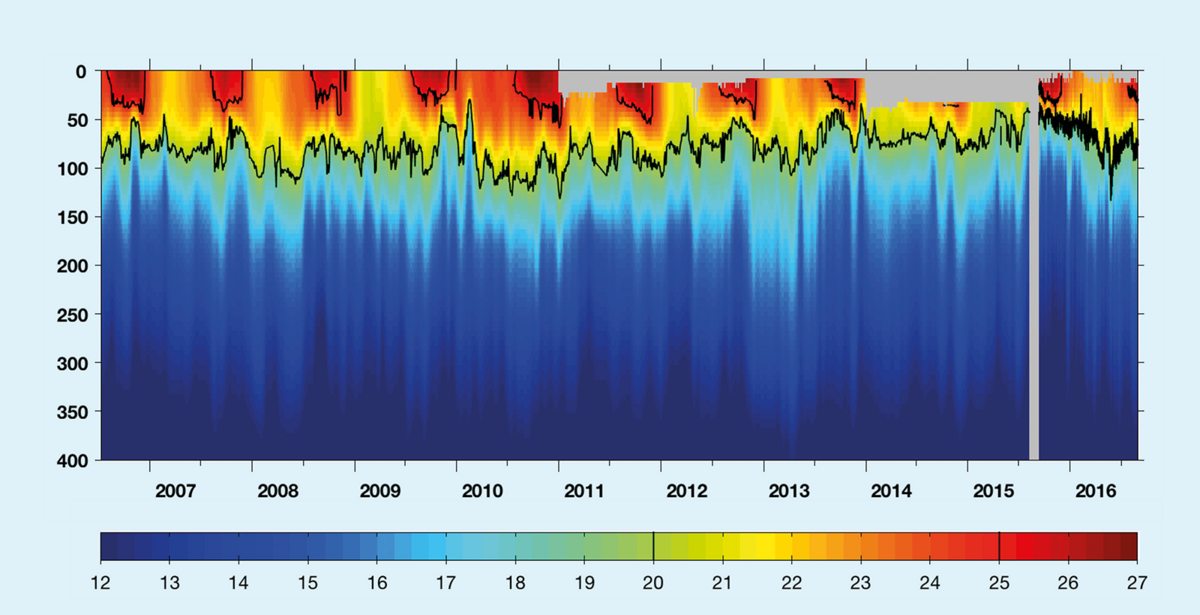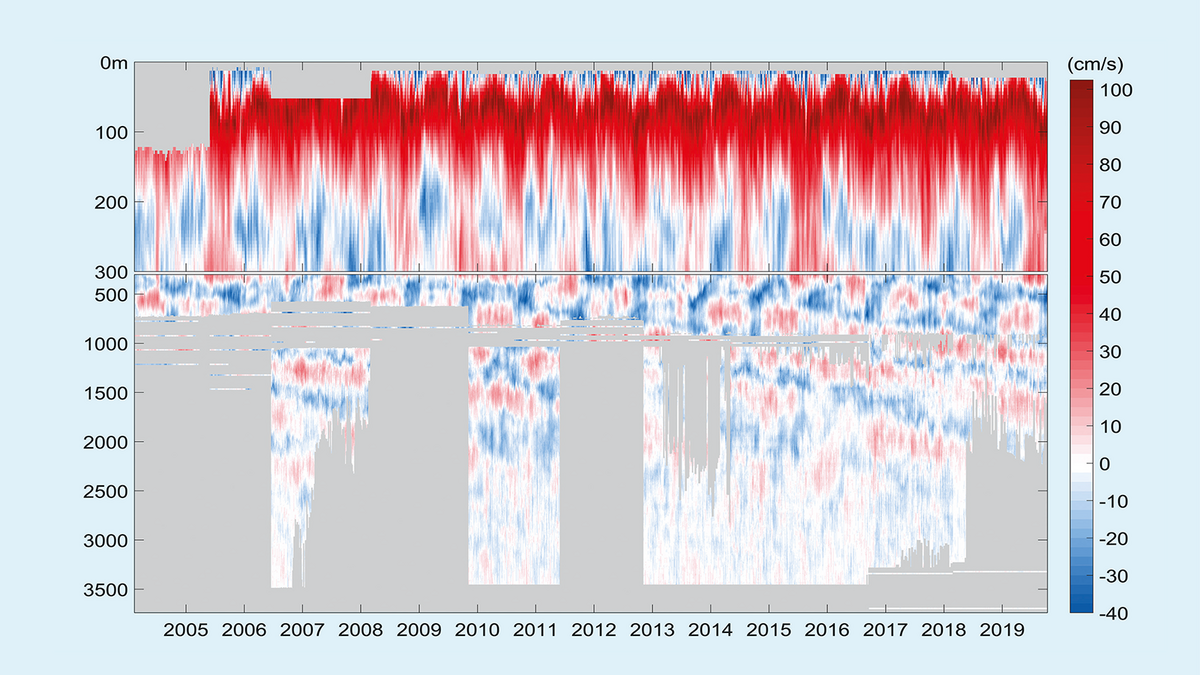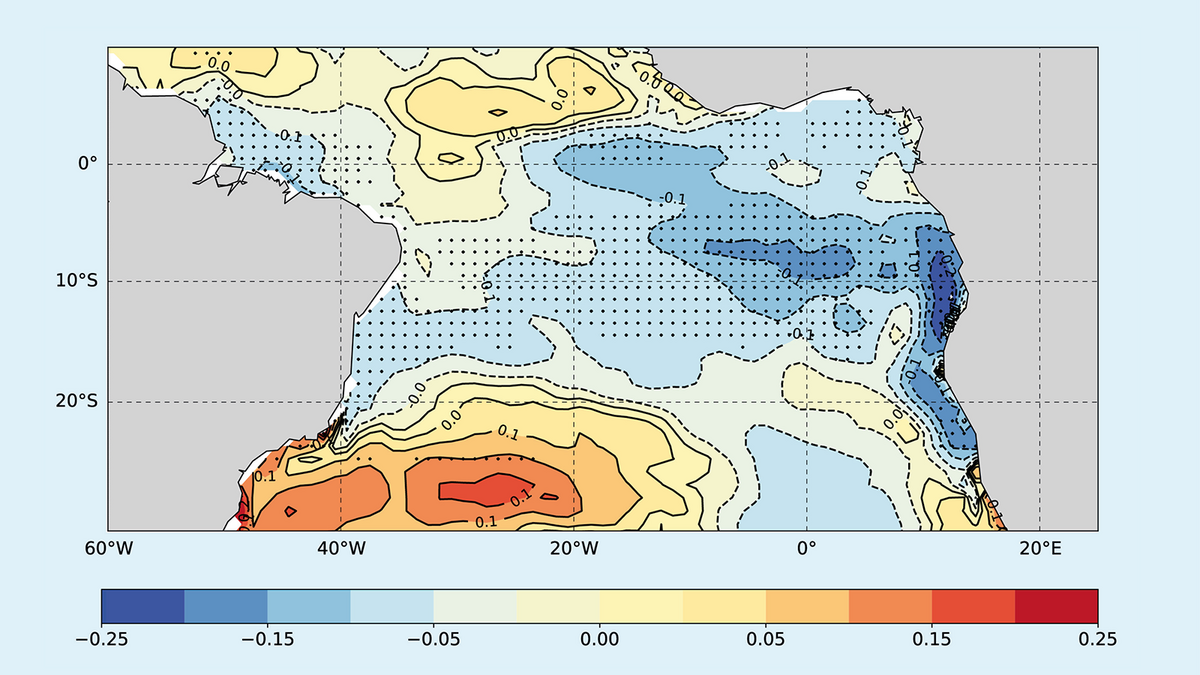Ocean Observation: Examples

At the core of the research activities of the Physical Oceanography unit are observational programmes on ocean dynamics with regard to the role of the ocean in the climate system, and with a special focus on the Atlantic Ocean. The large-scale circulation across ocean depths, physical processes at the sea surface and in the interior of the ocean, their effects on currents, deep water formation and the oceanic transport of heat and fresh water as well as their interactions with biological and chemical processes are focal points of the investigations.
Equatorial Currents

The equatorial Atlantic is characterised by particularly strong currents, which mainly run in an east-west direction due to the Earth's rotation. The strongest current is the Equatorial Undercurrent, which proceeds from west to east across the Atlantic at a water depth of about 80 metres at a speed of about four kilometres per hour (see figure) and supplies the biologically very productive upwelling areas in the east with nutrients. This current, but also the underlying deep circulation, is being measured at GEOMAR with a long-term observatory operated in collaboration with the international Prediction and Research Moored Array in the Tropical Atlantic (PIRATA) programme.
The observed long-term fluctuations of the equatorial circulation are particularly remarkable. For example, the eastward flow of the Equatorial Undercurrent has increased by about 20 per cent in the last ten years, especially in water depths of 100 to 200 metres. Such directly measured current fluctuations provide important explanations for changes observed elsewhere in the oxygen or nutrient distribution of the ocean. At greater depths between 300 and 2000 metres, regular multi-year fluctuations in the deep circulation could also be detected with the current measurements at the equator. In a cycle of about 4.5 years, the direction of the current changes in the depth (see figure). These signals can be followed from the depths to the sea surface. Through the cooperation of observational and theoretical physical oceanography, the formation mechanisms of these circulation fluctuations, but also their effects on the tropical climate, could be explained for the first time at GEOMAR.
Lower temperature fluctuations in the tropical Atlantic Ocean
In the tropical Atlantic, the near-surface water warms at intervals of several years. Such warm water events, where the sea surface temperature is significantly warmer than usual at the time of year, occur both in the eastern equatorial Atlantic and off the coast of Angola. They are also known as Atlantic and Benguela Niños and have major impacts on the marine ecosystem and fisheries as well as on precipitation in West Africa.
At GEOMAR, the analysis of observational data and model simulation is used to investigate the mechanisms that lead to the formation of such warm water events and how their characteristics have changed over the period of several decades and may continue to change under the influence of global climate change. Analysis of long time series of observed sea surface temperature shows that these events have become weaker and less frequent since 2000 (see figure). This decrease in surface temperature variability can be attributed to a weakening of the ocean-atmosphere interaction in the equatorial Atlantic and a reduced impact of wind variations at the equator on surface temperature off Angola. Whether these changes are related to climate change is still being researched.
Ocean Eddies
The current patterns in the ocean are characterised by eddies, as can also be observed in rivers, for example. Eddies in the ocean are sometimes a hundred kilometres or more in diameter and can exist for several months and even years, although eddies also move as a whole. Their rotation is clockwise or counterclockwise and can reach remarkable speeds of up to five kilometres per hour.
Eddies often differ greatly in their physical, biological and chemical properties from the surrounding water and are of great importance for many processes in the ocean. To sample eddies, scientists face special challenges, starting with finding the eddies in the first place. Measurements from satellites can often help here. In order to study the eddies, measurements need to be carried out simultaneously with several measurement platforms, such as those available to researchers through the Modular Observation Solutions for Earth Systems (MOSES) infrastructure. In this way, a spatially and temporally high-resolution image of the eddies and their surroundings can be recorded and studied. The formation and propagation of eddies is of great relevance for the exchange between the coasts and the open ocean. Eddies were also discovered in the tropical Atlantic, near the Cape Verde Ocean Observatory (CVOO), which had extremely low oxygen levels and were thus home to unusual organisms.




